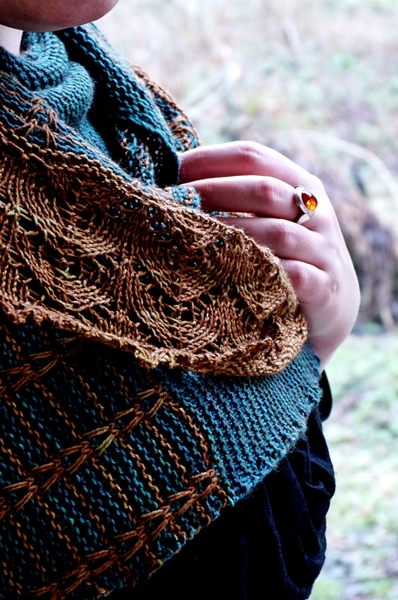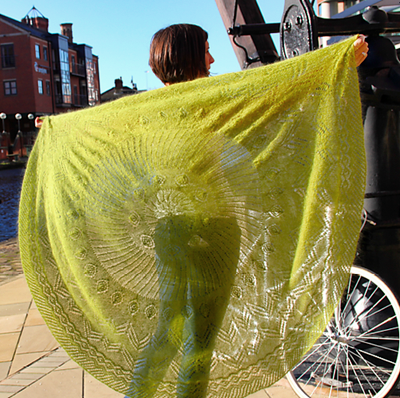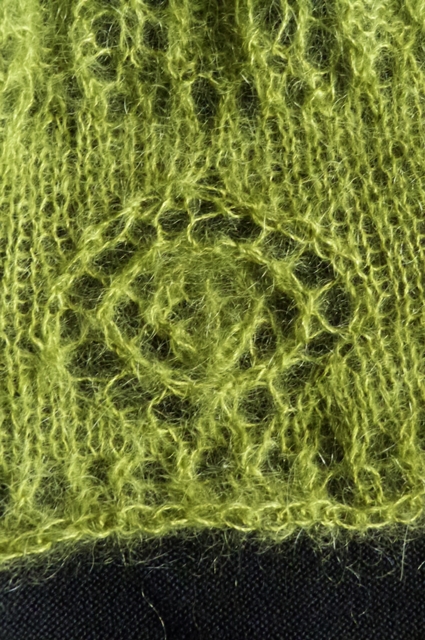A couple of months ago, I was approached by the talented and charismatic Ben who wanted my thoughts on designing and writing knitting patterns. Seeing as I have just finished Karise (pattern up early next week), I reckon now would be a good time to post those thoughts..
1) Define your design strategy in a word.
Intuitive.
2) In your work, what is the difference between successful and unsuccessful design?
I always design with a need in mind. A yarn to showcase or a technique to explain.
I have a really good idea about what knitters need because I meet and teach so many. I design many mini-projects that'll teach my students the techniques they need to know whilst still in context of where they'll use those techniques. (I don't release those patterns to the general public because they are so specific to my teaching but I have designed a lot).
Successful designs marry well-written instructions with a distinctive look and relative ease of knitting. Unsuccessful designs have hard-to-follow instructions or no distinct aesthetic.
I also think designs have to be authentic - I always find it unappealing if I can't see any trace of personality or obvious thought-process behind a pattern.
3)What does your review process look like?
I subscribe to the same view both in knitting and writing: keep it simple, stupid (KISS). I simplify, simplify, simplify. Kiss, kiss, kiss. Can I do without this bit? Does this shawl really need three different stitch patterns? Can I make this chart smaller without losing any information? I always take away far more than what I add.
I can't remember who said it but there is this quote about a sculptor whose job is simply to remove bits of marble to reveal the sculpture that was always within the block of marble. Chip, chip, chip..
4) As a creator, what is your biggest personal challenge.
Confidence has been a big one for me.
I am not the most confident person in the world (to say the least) and I have never really 'understood' fashion, so I did not think I had any business getting involved in designing. However, I have come to realise that there is a difference between being fashionable and being stylish - and I think I can definitely claim I have a personal style or aesthetic.. so that has played a big part in me getting involved in designing knitwear.
I had been asked to submit designs for many years now, actually, but it was not until last year that I had the confidence to put a self-designed pattern in front of other people. The response was fantastic and was a real confidence boost.
I'm now moving from teaching-related designing and small, locally-released patterns into releasing patterns, full stop. It feels slightly daunting. But also incredibly liberating.
5) What does development look like? How does an idea move from initial concept through to finished object?
My Karise shawl is a good example. Lilith gave me two hanks of her new 4ply yarn and asked me to design her shawl. She had requirements: a) the shawl should take less than 100g of sockweight yarn and b) it had to be downloadable from Ravelry by Knit Nation. That told me two things: the size of the shawl and the type of knitter. With Ravelry knitters in mind - who tend to be adventurous and curious - I sat down to doodle some sketches.
The yarn was a gorgeous mossy green-brown with real depth to it. Showcasing that colour was a no-brainer, so I included a large stocking-stitch element. I wanted to avoid using obvious leaf stitch patterns because I see so many shawl patterns with leaves but I still wanted the shawl to have an organic feel to it (the colour name - ghillie dhu - means 'guardian spirit of the trees'). I played around with grid paper until I had achieved a stitch pattern that flowed organically from one shape into another with minimal adjustments. Karise does have a certain forest-like feel to its lace but it's quite subtle.
After the initial lace chart, I swatched to make sure that it looked like I wanted it to look and to ensure my knitter's maths was correct. Then I did more knitter's maths before starting the shawl itself. I did rip out the shawl twice (to take away surplus elements) but that was pretty much it. I modified the hand-drawn lace charts as I was knitting the sample, then transferred all my notes to Excel and refined the charts.
6) What sources feed into your work? Are there any resources you'd recommend to other designer/makers?
I am an intensely visual person and I draw upon a lot of sources which people might think random for knitting designs.
I grew up with a keen interest in fashion and art history, so I have an 'inner library' of trends that I use a lot. I'm extremely passionate about late 19th C/early 20th C art and culture (including colour palettes), so that forms a huge chunk of my design vocabulary. There is definitely some Art Noveau-influences in Karise.
Finally, having grown up in Scandinavia, I am also influenced by Scandinavian design which tends towards sparseness, minimalism and functionalism. I shoot a lot of photos of brick walls, roof tiles, paving, and other patterns I notice in my surroundings.
My best advice is to keep your eyes open. There are token stitch dictionaries out there and they are obviously great resources, but keep your eyes open for anything that might come your way.You might find your greatest idea will come from a cereal box in your local supermarket.
7) You are writing the definitive knitwear-design Bible. What is the first commandment?
Thou must write clear and concise patterns. I cannot emphasise this enough.
Even the most extraordinary design is a failure if other people cannot follow your instructions. And complex design elements can become accessible through well-written patterns (Laminaria is my favourite example). Keep the end user in mind.
--
I have thoughts on indie designers, the new Knitty and even some finished object photos but I think all those things are better left for another day.. Hope your Monday is more sun-drenched than mine..
 Yesterday we went to Glasgow's Pollok Park to take in some much needed daylight. We also had a photo shoot of the first design in the Authors & Artist series. The pattern is off to its technical editor this week and I hope to release it this week (fingers crossed). I love how the photo shoot turned out and I cannot wait to share more photos with you.
The new design is inspired by one of my favourite authors - someone whose work has kept me company for twenty years (or thereabouts). It is all about layers, depth, and richness of thoughts and emotions.
Yesterday we went to Glasgow's Pollok Park to take in some much needed daylight. We also had a photo shoot of the first design in the Authors & Artist series. The pattern is off to its technical editor this week and I hope to release it this week (fingers crossed). I love how the photo shoot turned out and I cannot wait to share more photos with you.
The new design is inspired by one of my favourite authors - someone whose work has kept me company for twenty years (or thereabouts). It is all about layers, depth, and richness of thoughts and emotions.


